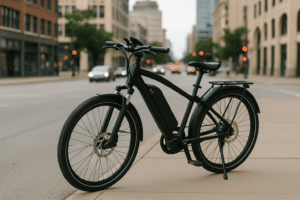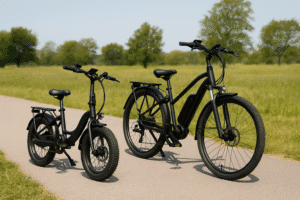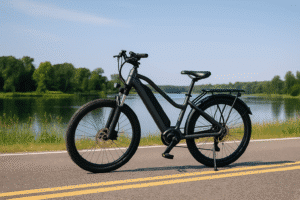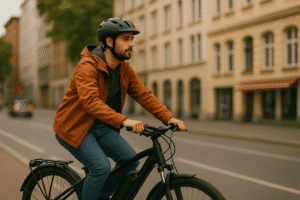Electric chopper bikes turn heads with their sleek, low-slung design and motorcycle-inspired style, but can you legally ride one on the road? The answer depends on motor power, speed, and local laws.
While some chopper e-bikes fit neatly into e-bike regulations, others cross into moped or motorcycle territory, requiring registration, insurance, or even a license.
So, what makes an electric chopper bike street-legal? And how do you know if your ride needs special paperwork?
In this guide, we’ll break down federal and state laws, explain which bikes can be legally ridden on the road, and help you avoid any surprises before you hit the streets.
What is an Electric Chopper Bike?
An electric chopper bike is a battery-powered bike with a low-slung frame, stretched-out handlebars, and a relaxed riding position, designed to look like a classic motorcycle. It offers the comfort of a cruiser with the convenience of an electric motor.
Unlike regular e-bikes, chopper-style electric bikes focus more on style, comfort, and power. They often have fat tires, full suspension, and more powerful motors, making them ideal for both city rides and open-road cruising.
Some models are built strictly for fun, while others are designed to be street-legal with proper lighting, turn signals, and DOT approval.
People love them because they turn heads, feel smooth on the road, and give you that motorcycle vibe without the gas engine.
Whether you want a laid-back ride for the beach or a powerful e-bike for urban commuting, there’s likely a chopper-style electric bike that fits your needs.
Are Electric Chopper Bikes Street Legal?
Yes, some electric chopper bikes are street-legal, but not all of them. It depends on motor power, top speed, and whether the bike meets safety standards.
If a chopper e-bike has 750W or less and stays under 28 MPH, it is usually treated as a bicycle and can be legally ridden without a license or registration.
However, if it has a more powerful motor (like 2000W or 4000W) and goes over 30 MPH, it is likely classified as a moped or motorcycle, meaning registration and a license may be required.
Many high-powered electric chopper bikes, like the eAhora M1P Pro, are DOT-approved, meaning they can be registered for road use just like a moped or motorcycle.
If you’re looking for a street-legal option, it’s best to choose a model that comes with DOT certification and meets local registration requirements.
Would you like to see some of the best street-legal chopper e-bikes? Check out the best electric chopper bikes for adults to find models that are built for the road.
Rising Popularity of Chopper E-Bikes

Electric chopper bikes are becoming more popular for one big reason: they’re fun to ride. They offer a comfortable, laid-back experience, making them perfect for riders who want more than just a basic e-bike. Instead of hunching over handlebars, you can kick back and cruise in style.
Another reason people love them? They look cool. Whether it’s the low-profile frame, the motorcycle-inspired design, or the smooth ride, chopper e-bikes grab attention wherever they go.
They stand out from the typical commuter e-bike and bring back that old-school chopper aesthetic—just with an electric motor.
Commuters are also jumping on board. Many of these bikes go faster and have better suspension than standard e-bikes, making them a comfortable choice for city riding. Instead of sweating it out in traffic, riders can cruise effortlessly while enjoying a smooth ride.
And let’s not forget the growing number of street-legal models. Some chopper-style e-bikes meet DOT standards, allowing riders to register them as mopeds or motorcycles, making them a legitimate alternative to gas-powered two-wheelers.
Understanding E-Bike Laws in the USA
Electric bike laws can get a little confusing because they vary state by state. But here’s what you need to know:
- Federal Law Defines E-Bikes as Bicycles (If They Meet Certain Limits)
- Max 750W motor power
- Top speed under 20 MPH on throttle alone
- Must have operable pedals
- The 3-Class System Used by Many States
- Class 1: Pedal-assist only, stops assisting at 20 MPH
- Class 2: Has a throttle, but still limited to 20 MPH
- Class 3: Pedal-assist only, but goes up to 28 MPH
What Happens if an E-Bike Exceeds These Limits?
If an e-bike has more than 750W or goes faster than 28 MPH, it doesn’t qualify as an e-bike anymore.
- Some states will classify it as a moped (which requires registration).
- Others might consider it a motorcycle, which could require a license and insurance.
Street-Legal E-Bikes vs. Mopeds & Motorcycles
- If an electric chopper bike follows Class 1, 2, or 3 e-bike rules, you can ride it like a bicycle in most places.
- If it’s more powerful (e.g., 2000W, 50MPH top speed), it likely needs to be registered as a moped or motorcycle to be legally used on the road.
Always check your state’s specific laws, as some have different rules on registration, helmets, and road use.
When an Electric Chopper Bike is NOT Street Legal
Not all electric chopper bikes can be ridden legally on public roads. If your bike falls into any of the following categories, you may need to register it as a moped or motorcycle or stick to private property.
- Motor Exceeds 750W – Most states consider e-bikes with more than 750 watts to be mopeds or motorcycles.
- Top Speed Over 28 MPH – If your bike can go faster than 28 MPH, it likely falls outside e-bike regulations.
- No Pedals – Some chopper-style electric bikes don’t have pedals, which disqualifies them from being classified as bicycles.
- Missing Safety Features – Lack of lights, reflectors, or turn signals can make a bike illegal for road use.
- Not DOT-Approved – If a high-powered bike isn’t DOT-certified, it may not qualify for registration as a legal motor vehicle.
State-Specific Regulations for Electric Chopper Bikes
E-bike laws are not the same everywhere. Some states follow federal guidelines, while others have stricter rules. Here’s a look at how different states regulate electric chopper bikes.
California
- Recognizes Class 1, 2, and 3 e-bikes (must be 750W or less).
- E-bikes don’t require registration or a license unless they exceed these limits.
- Class 3 riders must be at least 16 and wear a helmet.
Texas
- Allows 750W e-bikes under the Class 1-3 system.
- No registration or licensing needed for e-bikes under 28 MPH.
- Faster chopper-style e-bikes may require registration as mopeds or motorcycles.
New York
- Only allows Class 1 and 2 e-bikes statewide.
- Class 3 (up to 25 MPH) is legal in NYC but not the rest of the state.
- Higher-powered e-bikes must be registered as mopeds.
Florida
- No license or registration needed for e-bikes under 750W and 28 MPH.
- More powerful models must be registered and insured as mopeds.
Illinois
- Requires registration for any e-bike over 750W.
- Riders must be at least 16 to operate Class 3 e-bikes.
Before buying a chopper-style e-bike, check your local laws to avoid getting fined or having your bike impounded.
Consequences of Riding an Illegal Electric Chopper Bike
Riding a non-street-legal electric chopper bike on public roads can lead to big problems. Some states might be lenient, but others have strict enforcement.
If your bike isn’t registered but should be, you could be fined or ticketed for riding an unregistered motor vehicle. Some cities actively confiscate illegal e-bikes if they don’t meet road-use laws.
There’s also the issue of insurance and liability. If you get into an accident while riding an unregistered, high-powered e-bike, your insurance might not cover damages, leaving you to pay out of pocket.
Lastly, some areas have strict noise and traffic laws that apply to mopeds and motorcycles. Even if your electric chopper is quiet, if it looks like a moped or motorcycle, local law enforcement might pull you over and check its classification.
How to Make an Electric Chopper Bike Street Legal
If your electric chopper bike doesn’t currently meet street-legal requirements, you might be able to modify it to comply with local laws.
1. Add Pedals (If Necessary)
Many e-bike laws require operable pedals. If your chopper-style bike doesn’t have them, you may need to install a pedal system to qualify as an e-bike.
2. Limit Motor Power and Speed
If your bike exceeds 750W or 28 MPH, some models allow you to reduce the speed and power settings via the controller. This may help it fit within legal limits.
3. Install Required Safety Features
To be road-legal, a bike should have:
- Front and rear lights (especially if riding at night).
- Brake lights and turn signals (needed for moped classification).
- Mirrors and a horn (some states require these for mopeds).
4. Check for DOT Certification
If your e-bike can’t be adjusted to fit e-bike laws, see if it qualifies as a DOT-approved moped or motorcycle. If so, you can register it with your DMV for legal road use.
5. Register and Get a License (If Needed)
Some electric chopper bikes, like the eAhora M1P Pro, are DOT-approved, meaning they can be registered as mopeds or motorcycles. Check your state’s DMV website to see what paperwork is required.
Final Words
Not every electric chopper bike is ready for the road right out of the box. If it meets e-bike regulations—with a motor under 750W, a top speed of 28 MPH, and working pedals—it’s typically legal to ride without registration in most places.
But if it’s more powerful or lacks pedals, it might need to be registered as a moped or motorcycle before it can be used on public roads.
Before heading out, take a moment to check your local laws. If needed, you can modify your bike or complete the registration process to make it fully street-legal.
A little preparation now can save you from fines or restrictions later, making sure you can enjoy your ride without any legal headaches.
FAQs
Can I ride an electric chopper bike without a license?
If your bike meets e-bike regulations (750W max, 28 MPH limit, operable pedals), you don’t need a license in most states. But if it’s more powerful, you may need a moped or motorcycle license.
Do I need to register an electric chopper bike?
Not always. If your bike is classified as an e-bike, you can ride without registration. But if it has a high-powered motor (1000W or more) and goes over 30 MPH, it may need to be registered as a moped or motorcycle.
What happens if I ride an illegal electric chopper bike?
You could be ticketed, fined, or even have your bike impounded if it doesn’t meet local street-legal requirements. If you’re involved in an accident, you may also face legal trouble if your bike wasn’t registered properly.
Are all DOT-approved electric chopper bikes street-legal?
Not automatically. DOT approval means a bike meets road safety standards, but it still needs to be registered as a moped or motorcycle in many states. Check with your DMV before riding.
Can I make a high-powered electric chopper bike street-legal?
Yes, in some cases. You might need to limit its speed, add pedals, install required safety features, and register it as a moped or motorcycle. Some bikes, like the eAhora M1P Pro, are designed to be registered for road use.
What’s the best street-legal electric chopper bike?
It depends on your needs. If you want a powerful, DOT-approved model, the eAhora M1P Pro is a great choice. If you need something more bike-lane-friendly, check out lower-powered options under 750W.
Michael Josh is a hands-on e-bike tester and reviewer at BoltBikers, known for putting every model through real-world rides before sharing his thoughts. With a sharp eye for performance, comfort, and build quality, he helps the team choose which bikes are worth featuring. Backed by years of experience in tech and gear reviews, Michael brings trusted, honest insights to help readers find the right e-bike for their needs.








